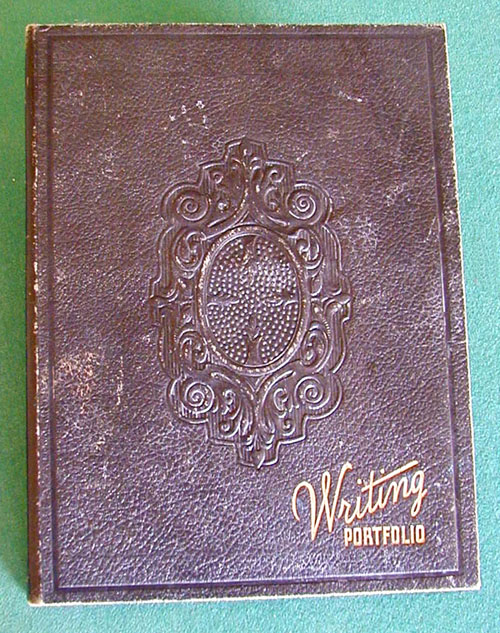|
The First Writing Portfolio |
The writing portfolio displayed here is simply a folder of pressed cardboard (8.5" by 11.5") that, opened up, offers receptacles for mailing envelopes and a flat surface on which to write (inside view). It served as a portable desk that people could take with them on trips and work at their correspondence. Fancier writing portfolios were available, of course, with several leaves, compartments for stamps, and straps for fountain pens. I should say are available, since you can still buy writing portfolios at upscale leather stores. Ghurka offers a selection ranging from $200-500. No competition with this one, which I bought at an antique shop in Corpus Christi, Texas for $1.25, and which may have originally been purchased at a Kresge nickel and dime store for one or the other. Historically, as the term for a sheaf of writings by one student to be used for formal assessment or for instructional diagnosis and grading, "portfolio" had to battle it out with two other words: "folder" and "binder." In the United States it wasn't until about 1985 that "portfolio" won out, in part through the brevet of Pat Belanoff and Peter Elbow (check titles and search terms in CompPile). As a more general term for a binder or case that holds loose sheets (drawings, music, maps, documents, etc.) the word goes back to the late 17th century. The earliest form was portefeuille, reminding us again that just getting rid of "French fries," "French toast," and "French kiss" will do little to cleanse our tongue of the vast contribution of the French language. RH, September 2005 |
 Enter
"writing portfolio" into Google and you'll get 200,000 hits. Such
is the popularity today of portfolios in the teaching and assessment
of writing. Enter "writing portfolio + vintage," however,
and you'll find a "writing portfolio" of a different and earlier
kind.
Enter
"writing portfolio" into Google and you'll get 200,000 hits. Such
is the popularity today of portfolios in the teaching and assessment
of writing. Enter "writing portfolio + vintage," however,
and you'll find a "writing portfolio" of a different and earlier
kind.